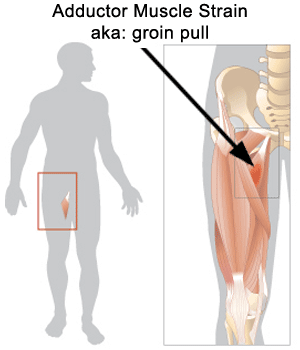Groin strain or pull. March 23, 2010
Posted by Joanna Wilson in Uncategorized.Tags: groin pull, groin strain, Phsyiotherapy, physiocare, physiotherapy reading, RICE, RICE Treatment, Sporting injury, sporting injury reading, Sports injury, sports injury reading
trackback
 Groin pull or strains are common in many sports including football and swimming. It occurs when one of the five abductor muscles of the groin, namely the adductor longus, adductor brevis, adductor magnus, gracilis, and pectineus, is pulled during an activity stretching the muscle beyond its normal extension or a sudden change in direction whilst running. The adductors are fan-like muscles in the upper thigh that pull the legs together when they contract. They also help stabilize the hip joint.
Groin pull or strains are common in many sports including football and swimming. It occurs when one of the five abductor muscles of the groin, namely the adductor longus, adductor brevis, adductor magnus, gracilis, and pectineus, is pulled during an activity stretching the muscle beyond its normal extension or a sudden change in direction whilst running. The adductors are fan-like muscles in the upper thigh that pull the legs together when they contract. They also help stabilize the hip joint.
Causes of groin injuries are varied but some are preventable. The abductor muscles are constantly moving in many directions during workouts and must be able to withstand these forces. Overuse of these muscles will cause them to become irritated. An adequate warm up will prepare the muscles to help prevent too great a strain causing an injury.
Symptoms of a groin strain depend on the severity of the injury. These are classified into three grades. Grade 1 is a minor strain, usually a bruise to the abductor muscle, causing mild discomfort and tenderness but little or no swelling. Injury may not be noticed until activity stops, and there should be no impediment to walking.
Grade 2 strain involves stretched or torn muscle fibres and bruising of the hip bone and will begin with a sharp sudden pain in the groin area, accompanied with swelling. It will be painful to the touch and muscle will become tight. Bruising may also be present after a couple of days. There will be reduced range of motion with walking and running impairment.
A grade 3 strain is multiple ruptured muscles with possibly a separation of a tendon and will be very painful with substantial swelling and bruising with an inability to mobilise. There will be an inability to contract the groin muscle and pain on stretching.
Minor strains can be treated using R.I.C.E treatment. Rest the injury initially to prevent further damage. If swelling is present, apply ice frequently for about 20 minutes for up to 48 hours. Elevate the injured leg and compress the site of injury. If the injury is painful, take over the counter anti-inflammatory medication. If pain is severe and mobility is severely affected, seek medical attention. A sports physiotherapist will be able to help with rehabilitation and advice on appropriate abductor muscle stretching and strengthening exercises.
Comments»
No comments yet — be the first.